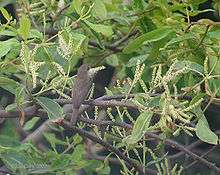Terminalia arjuna
| Terminalia arjuna | |
|---|---|
 | |
| Arjuna fruit | |
 | |
| Arjuna flowers with a Sykes's warbler | |
| Scientific classification | |
| Kingdom: | Plantae |
| (unranked): | Angiosperms |
| (unranked): | Eudicots |
| (unranked): | Rosids |
| Order: | Myrtales |
| Family: | Combretaceae |
| Genus: | Terminalia |
| Species: | T. arjuna |
| Binomial name | |
| Terminalia arjuna (Roxb.) Wight & Arn. | |
Terminalia arjuna is a tree of the genus Terminalia. It is commonly known as arjuna[1] or arjun tree in English,[2] thella maddi in Telugu, kumbuk in Sinhala, marudha maram in Tamil and neer maruthu in Malayalam.
Description
The arjuna is about 20–25 metres tall; usually has a buttressed trunk, and forms a wide canopy at the crown, from which branches drop downwards. It has oblong, conical leaves which are green on the top and brown below; smooth, grey bark; it has pale yellow flowers which appear between March and June; its glabrous, 2.5 to 5 cm fibrous woody fruit, divided into five wings, appears between September and November.[1][2]
Distribution and habitat
The arjuna is usually found growing on river banks or near dry river beds in Bangladesh, Uttar Pradesh, Madhya Pradesh, West Bengal and south and central India.[1][3] It is known as matthimara in Kannada, neer maruthu in Malayalam 'marutha maram' (marutham pattai) in Tamil,[4][5] thella maddi (తెల్ల మద్ది) in Telugu and kohda in Rajasthan.
Importance
Silk production
The arjuna is one of the species whose leaves are fed on by the Antheraea paphia moth which produces the tassar silk, a wild silk of commercial importance.[6]
Alternative medicine
The arjuna was introduced into Ayurveda as a treatment for heart disease by Vagbhata (c. 7th century CE).[7] It is traditionally prepared as a milk decoction.[7] In the Ashtānga Hridayam, but was also mentioned in many ancient Indian vedas, and was a known practice for thousands of years, passed down by tradition, before vagbhata mentioned it in his writings. Vagbhata mentions arjuna in the treatment of wounds, hemorrhages and ulcers, applied topically as a powder. Arjuna is an excellent medicine for Heart, it has the capability to even reverse heart failure.[7][8][9] The Arjuna plant (lat. Terminalia Arjuna) has traditionally been used to treat heart disease for centuries, which is why it got the nickname “Guardian of the heart.” It’s named after the hero of the famous epic “Mahabharata”, because of its protective effects. Arjuna is an evergreen tree of the Combretaceae family, which grows along the rivers of West Bengal in the drained beds of central and southern India. In Ayurveda,it’s considered a sacred plant.
Scientific Research
Recent studies in rat model have shown its preventive potential in monocrotaline induced pulmonary artery hypertension. It prevents rise in right ventricular systolic pressure, right ventricular hypertrophy, % medial wall thickness, echo-cardiographic changes through inhibition of reactive oxygen species (ROS)Reactive_oxygen_species mediated pulmonary vascular remodeling. It has also been identified to inhibit NADPH oxidase (NOX1)NADPH_oxidase in lung homogenate.[10]
In Buddhism
In Theravada Buddhism, arjuna is said to have used as the tree for achieved enlightenment, or Bodhi by tenth Lord Buddha called "Anomadassi - අනෝමදස්සී". The plant is known as කුඹුක් (kumbuk) in Sinhala in Sri Lanka.
Gallery
 Terminalia arjuna
Terminalia arjuna- Terminalia arjuna middle trunk
- Terminalia arjuna leaves
 Terminalia arjuna in Bagh-e-Jinnah, Lahore
Terminalia arjuna in Bagh-e-Jinnah, Lahore- The bark of Terminalia arjuna (অর্জুন) is found in Bana Bitan, Kolkata, West Bengal,India
References
- 1 2 3 Biswas, Moulisha; Biswas, Kaushik; Karan, Tarun K; Bhattacharya, Sanjib; Ghosh, Ashoke K; Haldar, Pallab K (2011). "Evaluation of analgesic and anti-inflammatory activities of Terminalia arjuna leaf". Journal of Phytology. 3 (1): 33–8.
- 1 2 "Arjun Tree". Eco India.
- ↑ Rastogī, Rekhā (2008). Let Us Identify The Useful Trees(New). Children's Book Trust. p. 7,8. ISBN 978-81-7011-919-7.
- ↑ "GERIATRICS AND SIDDHA MEDICINE".
- ↑ "Terminalia arjuna prevents any heart disease".
- ↑ M.P. Shiva, NWFP, & EC-FAO Partnership Programme. "Non-wood forest products In 15 countries of Tropical Asia". Food and Agriculture Organization of the United Nations.
- 1 2 3 "Arjuna". Todd Caldecott. Retrieved 2012-11-26.
- ↑ Bharani A, Ganguly A, Bhargava KD (May 1995). "Salutary effect of Terminalia Arjuna in patients with severe refractory heart failure". International Journal of Cardiology. 49 (3): 191–9. doi:10.1016/0167-5273(95)02320-V. PMID 7649665.
- ↑ Dwivedi S, Jauhari R (1997). "Beneficial effects of Terminalia arjuna in coronary artery disease". Indian Heart Journal. 49 (5): 507–10. PMID 9505018.
- ↑ Meghwani, Himanshu; Prabhakar, Pankaj; Mohammed, Soheb A.; Seth, Sandeep; Hote, Milind P.; Banerjee, Sanjay K.; Arava, Sudheer; Ray, Ruma; Maulik, Subir Kumar (2016). "Beneficial effects of aqueous extract of stem bark of Terminalia arjuna (Roxb.), An ayurvedic drug in experimental pulmonary hypertension". Journal of Ethnopharmacology. doi:10.1016/j.jep.2016.07.029. PMID 27401289.
External links
| Wikimedia Commons has media related to Terminalia arjuna. |
| Wikispecies has information related to: Terminalia arjuna |
- Dwivedi S (November 2007). "Terminalia arjuna Wight & Arn.—A useful drug for cardiovascular disorders". Journal of Ethnopharmacology. 114 (2): 114–29. doi:10.1016/j.jep.2007.08.003. PMID 17875376.
- Karthikeyan K, Bai BR, Gauthaman K, Sathish KS, Devaraj SN (October 2003). "Cardioprotective effect of the alcoholic extract of Terminalia arjuna bark in an in vivo model of myocardial ischemic reperfusion injury". Life Sciences. 73 (21): 2727–39. doi:10.1016/S0024-3205(03)00671-4. PMID 13679240.
- Meghwani H, Prabhakar P, Mohammed SA, Seth S, Hote MP, Banerjee SK, Arava S, Ray R, Maulik SK (July 2016). "Beneficial effects of aqueous extract of stem bark of Terminalia arjuna (Roxb.), An ayurvedic drug in experimental pulmonary hypertension". J Ethnopharmacol. 16. doi:10.1016/j.jep.2016.07.029. PMID 27401289.